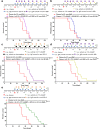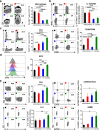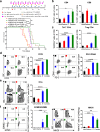Combination therapy targeting both innate and adaptive immunity improves survival in a pre-clinical model of ovarian cancer
- PMID: 31362778
- PMCID: PMC6668091
- DOI: 10.1186/s40425-019-0654-5
Combination therapy targeting both innate and adaptive immunity improves survival in a pre-clinical model of ovarian cancer
Abstract
Background: Despite major advancements in immunotherapy among a number of solid tumors, response rates among ovarian cancer patients remain modest. Standard treatment for ovarian cancer is still surgery followed by taxane- and platinum-based chemotherapy. Thus, there is an urgent need to develop novel treatment options for clinical translation.
Methods: Our approach was to analyze the effects of standard chemotherapy in the tumor microenvironment of mice harboring orthotopic, syngeneic ID8-Vegf-Defb29 ovarian tumors in order to mechanistically determine a complementary immunotherapy combination. Specifically, we interrogated the molecular and cellular consequences of chemotherapy by analyzing gene expression and flow cytometry data.
Results: These data show that there is an immunosuppressive shift in the myeloid compartment, with increased expression of IL-10 and ARG1, but no activation of CD3+ T cells shortly after chemotherapy treatment. We therefore selected immunotherapies that target both the innate and adaptive arms of the immune system. Survival studies revealed that standard chemotherapy was complemented most effectively by a combination of anti-IL-10, 2'3'-cGAMP, and anti-PD-L1. Immunotherapy dramatically decreased the immunosuppressive myeloid population while chemotherapy effectively activated dendritic cells. Together, combination treatment increased the number of activated T and dendritic cells as well as expression of cytotoxic factors. It was also determined that the immunotherapy had to be administered concurrently with the chemotherapy to reverse the acute immunosuppression caused by chemotherapy. Mechanistic studies revealed that antitumor immunity in this context was driven by CD4+ T cells, which acquired a highly activated phenotype. Our data suggest that these CD4+ T cells can kill cancer cells directly via granzyme B-mediated cytotoxicity. Finally, we showed that this combination therapy is also effective at delaying tumor growth substantially in an aggressive model of lung cancer, which is also treated clinically with taxane- and platinum-based chemotherapy.
Conclusions: This work highlights the importance of CD4+ T cells in tumor immunology. Furthermore, the data support the initiation of clinical trials in ovarian cancer that target both innate and adaptive immunity, with a focus on optimizing dosing schedules.
Keywords: CD4+ T cells; Cancer immunotherapy; Combination therapy; Innate immunity; Ovarian cancer.
Conflict of interest statement
J.L.G. is a consultant for GSK and receives sponsored research support from GSK and Eli Lilly. No other authors have any conflicts related to this work.
Figures






Similar articles
-
Combined Trabectedin and anti-PD1 antibody produces a synergistic antitumor effect in a murine model of ovarian cancer.J Transl Med. 2015 Jul 29;13:247. doi: 10.1186/s12967-015-0613-y. J Transl Med. 2015. PMID: 26219551 Free PMC article.
-
Carboplatin and programmed death-ligand 1 blockade synergistically produce a similar antitumor effect to carboplatin alone in murine ID8 ovarian cancer model.J Obstet Gynaecol Res. 2018 Feb;44(2):303-311. doi: 10.1111/jog.13521. Epub 2017 Nov 24. J Obstet Gynaecol Res. 2018. PMID: 29171115
-
STING agonist therapy in combination with PD-1 immune checkpoint blockade enhances response to carboplatin chemotherapy in high-grade serous ovarian cancer.Br J Cancer. 2018 Aug;119(4):440-449. doi: 10.1038/s41416-018-0188-5. Epub 2018 Jul 26. Br J Cancer. 2018. PMID: 30046165 Free PMC article.
-
Local and systemic immunosuppression in pancreatic cancer: Targeting the stalwarts in tumor's arsenal.Biochim Biophys Acta Rev Cancer. 2020 Aug;1874(1):188387. doi: 10.1016/j.bbcan.2020.188387. Epub 2020 Jun 21. Biochim Biophys Acta Rev Cancer. 2020. PMID: 32579889 Free PMC article. Review.
-
Programmed death-1 pathway blockade produces a synergistic antitumor effect: combined application in ovarian cancer.J Gynecol Oncol. 2017 Sep;28(5):e64. doi: 10.3802/jgo.2017.28.e64. Epub 2017 Jun 5. J Gynecol Oncol. 2017. PMID: 28657225 Free PMC article. Review.
Cited by
-
Immunotherapy for Ovarian Cancer: Adjuvant, Combination, and Neoadjuvant.Front Immunol. 2020 Oct 6;11:577869. doi: 10.3389/fimmu.2020.577869. eCollection 2020. Front Immunol. 2020. PMID: 33123161 Free PMC article. Review.
-
Current Advances in PD-1/PD-L1 Blockade in Recurrent Epithelial Ovarian Cancer.Front Immunol. 2022 Jun 27;13:901772. doi: 10.3389/fimmu.2022.901772. eCollection 2022. Front Immunol. 2022. PMID: 35833132 Free PMC article. Review.
-
The Complement System in Ovarian Cancer: An Underexplored Old Path.Cancers (Basel). 2021 Jul 28;13(15):3806. doi: 10.3390/cancers13153806. Cancers (Basel). 2021. PMID: 34359708 Free PMC article. Review.
-
Engineered IL-7 synergizes with IL-12 immunotherapy to prevent T cell exhaustion and promote memory without exacerbating toxicity.Sci Adv. 2023 Dec;9(48):eadh9879. doi: 10.1126/sciadv.adh9879. Epub 2023 Nov 29. Sci Adv. 2023. PMID: 38019919 Free PMC article.
-
Targeting Macrophages with CAR T Cells Delays Solid Tumor Progression and Enhances Antitumor Immunity.Cancer Immunol Res. 2022 Nov 2;10(11):1354-1369. doi: 10.1158/2326-6066.CIR-21-1075. Cancer Immunol Res. 2022. PMID: 36095236 Free PMC article.
References
-
- ACS. Cancer Facts & Figures. Atlanta: American Cancer Society; 2018.
-
- ORCFA. Statistics: Ovarian Cancer Resarch Fund Alliance, New York, New York, USA; 2018
-
- Sato E, Olson SH, Ahn J, Bundy B, Nishikawa H, Qian F, Jungbluth AA, Frosina D, Gnjatic S, Ambrosone C, et al. Intraepithelial CD8+ tumor-infiltrating lymphocytes and a high CD8+/regulatory T cell ratio are associated with favorable prognosis in ovarian cancer. Proc Natl Acad Sci U S A. 2005;102:18538–18543. doi: 10.1073/pnas.0509182102. - DOI - PMC - PubMed
Publication types
MeSH terms
Substances
LinkOut - more resources
Full Text Sources
Medical
Research Materials
Miscellaneous
